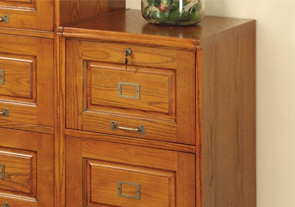Organize Your Office: Increase productivity in four simple steps
Having busy employees often means a workspace littered with cluttered desks. Last month's sales report gets covered up by this week's meeting schedule, which gets covered up with yesterday's memo, which gets covered up by notes from today's conference call. Suddenly, you need that sales report — and your office gets even messier when you move things around to find what you're looking for.
Let's face it, time is money, and wasted time is wasted money. Despite ever-increasing reliance on digital technology such as email and spreadsheets, today's workers are still often overwhelmed with papers of all kinds. How can you improve your office organization in the midst of a paper trail as long as your company's history?
Step 1: Clean off your desk — and keep it straight
Start simple. Your desk is probably where you spend the majority of your time. Sort similar items together. Depending on the size of your paper pile, you may want to sort into broad categories, and then refine each "mini-pile" until everything has a home.
Don't forget that "a home" can be the nearest trash can! If you don't need it, trash it! Software giant Microsoft has reported that workers actually use only 15-percent of what they file away; that means that 85-percent of what's on your desk is unnecessary — the key is figuring out which 15-percent to save!Pass off papers about projects you're no longer involved in; if you're unsure if you'll need a certain file, ask around to see if it's important, especially since many companies have different policies about tossing out confidential business information.
Once you get your desk uncluttered, you'll have a sense of relief. But how do you build office organization habits so you don't fall back on your old ways? For starters, don't let anyone else clutter your space. Add office file racks outside your door or cubicle and instruct co-workers and supervisors to place new files there. Then, when you finish what you're working on (and file away those papers), you can retrieve the new documents to begin the next project. This trick also works well during sick days or vacations, so you don't return to a desk full of disorganized stress!
Step 2: File old papers away — where you can easily locate them

Once you have a smaller pile of needed materials, consider what you'll need to keep close by and what can be filed away. Filing cabinet options are plentiful and don't have to take up a lot of space. Some models are designed to fit under desks and can be rolled out for easy but secure access to important documents. Options that hold more files don't have to be harsh on the eyes, though. A far cry from the loud metal filing systems seen in typical offices, wooden filing cabinets can blend in with your office decor.
For larger items, such as books, magazines, manuals and other reference material, invest in an office bookshelf or storage cabinets. This storage option doesn't take up much space but will allow you to keep necessary reading material within arm's reach.
For items that are shared by several departments or offices, invest in a sturdy commercial utility cart. These are ideal for reference books, internal documentation and other office materials.
Step 3: Organize the outside
The need for organization doesn't stop at your company's interior. From areas shared by employees to the front entrance seen by your customers and guests, a well-organized outdoor space boosts confidence in your company.
Provide adequate waste disposal locations and seating around all entrances and exits of your facility. In addition to typical trash cans, also encourage your employees to "be green" by providing recycling bins inside and outside your business. And, don't forget to place at least one cigarette receptacle to designate the proper smoking area — you certainly don't want cigarette butts littered in your landscaped area or even your parking lot! Cigarette ash urns should be placed near your facility's front door, as well, so visitors discard the butt properly.
Organization isn't about just trash and papers. Beautify your office space with evergreen plants or seasonal flowers in commercial-grade planters. Larger commercial campuses and educational facilities — even hotels, parks, apartment complexes and condominium properties can also help guide their new residents and visitors with enclosed bulletin boards that show important points of reference.
Step 4: Keep customer areas tidy and presentable
As the old adage says, you only get one chance to make a first impression. Don't expose disorganization to your customers, clients or the general public! A cluttered office gives customers the idea that your company is unprofessional or unable to handle more business. Make sure your front office, conference rooms and any other areas that have a chance of being seen by the public are in tip-top shape. Your entryway, waiting room or front office should have beautifully displayed reading material to make your customers comfortable and keep their eyes off the clock when you're running a bit behind schedule.
If your company has booklets or other corporate literature, make it easily accessible to your clients as they enter your door. Many types and sizes of brochure displays are available, depending on your business's needs.
Bonus Tip: Office organization starts from the top
To foster office organization throughout your entire facility, lead by example. When management makes changes, employees take notice. It works much better than sending out a sternly worded memo or email… which may only be another piece of paper to add to the mess. Provide funds to allow your staff to add organization items to their workspace, or simply provide filing cabinets, door racks and desk organizers to all employees.

